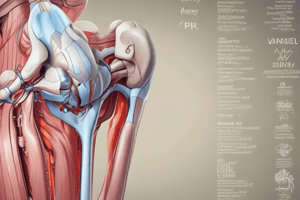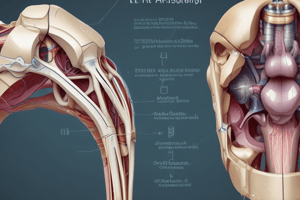Podcast
Questions and Answers
In the anatomical position, what is the orientation of the palms?
In the anatomical position, what is the orientation of the palms?
- Facing downward
- Facing forward (correct)
- Facing upward
- Facing backward
What is the term for the position where a person is lying on their back, arms by the side, face and trunk facing upward?
What is the term for the position where a person is lying on their back, arms by the side, face and trunk facing upward?
- Prone position
- Sitting position
- Lithotomy position
- Supine position (correct)
What is the region of the trunk that includes the chest area?
What is the region of the trunk that includes the chest area?
- Thoracic region (correct)
- Abdominal region
- Cervical region
- Pelvic region
What is the name of the region that includes the head and neck?
What is the name of the region that includes the head and neck?
How many organ systems are in the human body?
How many organ systems are in the human body?
What is the term for the molecules that make up organelles and other cellular components?
What is the term for the molecules that make up organelles and other cellular components?
What is the term for the collective structures that carry out specific functions within a cell?
What is the term for the collective structures that carry out specific functions within a cell?
What is the term for the region that includes the arms and legs?
What is the term for the region that includes the arms and legs?
What is the term for the region of the upper limb that includes the wrist?
What is the term for the region of the upper limb that includes the wrist?
Which anatomical plane divides the body into superior and inferior parts?
Which anatomical plane divides the body into superior and inferior parts?
What is the term for the plane that passes through the body at an oblique angle?
What is the term for the plane that passes through the body at an oblique angle?
Which region of the lower limb includes the ankle?
Which region of the lower limb includes the ankle?
What is the term for the median plane that passes through the midline of the body?
What is the term for the median plane that passes through the midline of the body?
Which anatomical plane divides the body into anterior and posterior parts?
Which anatomical plane divides the body into anterior and posterior parts?
What is the term for the region of the upper limb that includes the arm?
What is the term for the region of the upper limb that includes the arm?
Which of the following is NOT one of the four major anatomical planes?
Which of the following is NOT one of the four major anatomical planes?
What is the primary focus of clinical anatomy?
What is the primary focus of clinical anatomy?
What is the main reason for considering individual variation in human structure?
What is the main reason for considering individual variation in human structure?
What is the characteristic of an organ that distinguishes it from adjacent organs?
What is the characteristic of an organ that distinguishes it from adjacent organs?
What is the smallest unit of an organism considered to be alive?
What is the smallest unit of an organism considered to be alive?
Which of the following organs may be absent in some individuals?
Which of the following organs may be absent in some individuals?
What is the term for the study of anatomical landmarks important for surgical procedures?
What is the term for the study of anatomical landmarks important for surgical procedures?
Which of the following exhibits the least variation in human structure?
Which of the following exhibits the least variation in human structure?
What is the level of organization that comprises a group of organs that carry out a basic function of the organism?
What is the level of organization that comprises a group of organs that carry out a basic function of the organism?
Flashcards
Organelles
Organelles
Microscopic structures within a cell that perform individual functions.
Molecules
Molecules
Particles of at least two atoms joined by chemical bonds.
Macromolecules
Macromolecules
The largest molecules, including proteins, fats, and DNA.
Organ system
Organ system
Signup and view all the flashcards
Anatomical position
Anatomical position
Signup and view all the flashcards
Supine position
Supine position
Signup and view all the flashcards
Prone position
Prone position
Signup and view all the flashcards
Lithotomy position
Lithotomy position
Signup and view all the flashcards
Axial region
Axial region
Signup and view all the flashcards
Appendicular region
Appendicular region
Signup and view all the flashcards
Upper limb
Upper limb
Signup and view all the flashcards
Lower limb
Lower limb
Signup and view all the flashcards
Sagittal plane
Sagittal plane
Signup and view all the flashcards
Coronal (frontal) plane
Coronal (frontal) plane
Signup and view all the flashcards
Transverse plane
Transverse plane
Signup and view all the flashcards
Oblique plane
Oblique plane
Signup and view all the flashcards
Organism
Organism
Signup and view all the flashcards
Organ
Organ
Signup and view all the flashcards
Tissue
Tissue
Signup and view all the flashcards
Cells
Cells
Signup and view all the flashcards
Study Notes
Organelles and Cellular Components
- Organelles are microscopic structures within a cell that perform individual functions
- Organelles and other cellular components are composed of molecules, which are particles of at least two atoms j oined by chemical bonds
- Macromolecules are the largest molecules, including proteins, fats, and DNA
Human Organ Systems
- There are eleven organ systems in the human body
- Some organs belong to two or more systems, such as the male urethra belonging to both the urinary and reproductive systems
Terms Related to Position
- Anatomical position: standing erect with the head level, eyes facing forward, upper limbs by the sides with palms facing forward, and lower limbs parallel with feet flat on the floor
- Supine position: lying on the back with arms by the sides and face upwards
- Prone position: lying on the face with chest and abdomen downwards
- Lithotomy position: lying on the back with legs up and feet supported in straps
Body Regions
- Axial region: includes the head, neck, and trunk (thoracic, abdominal, and pelvic regions)
- Appendicular region: includes the upper limbs and lower limbs (also called appendages or extremities)
- Upper limb: includes arm, forearm, wrist, hand, and fingers
- Lower limb: includes thigh, leg, ankle, foot, and toes
Anatomical Planes
- Sagittal plane: divides the body into right and left portions
- Coronal (frontal) plane: divides the body into anterior (front) and posterior (back) parts
- Horizontal, or transverse plane: divides the body into superior (upper) and inferior (lower) parts
- Oblique plane: passes through the body at an angle other than 90°
Variations in Human Structure
- Individuals vary in physical appearance and anatomical features
- Variations occur in bone shape, muscle attachments, and branching patterns of veins, arteries, and nerves
- Some people lack certain organs or have extra ones, such as an extra spleen or kidney
Levels of Human Structure
- Organism: composed of organ systems
- Organ system: a group of organs that performs a basic function of the organism
- Organ: a structure with definite anatomical boundaries, composed of two or more tissue types working together to carry out a particular function
- Tissue: a mass of similar cells and cell products that forms a discrete region of an organ and performs a specific function
- Cells: the smallest units of an organism considered to be alive
Studying That Suits You
Use AI to generate personalized quizzes and flashcards to suit your learning preferences.




